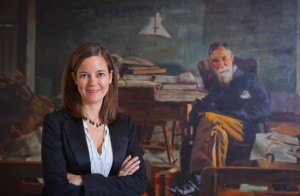
When Alix Ohlin was in graduate school at the Michener Center for Writers in Austin, Texas, she had an idea for a novel, but lacked the confidence to start it.
“I was worried it might not pan out,” she says.
So after class one day she asked her professor, Scottish writer James Kelman, for his opinion.
Kelman, Ohlin says, looked her in the eye and said, “Make art. Be bold. Take risks. Don’t wait another second.”
Author of two books, with another two scheduled for release in January 2012, Ohlin, associate professor of English, now passes Kelman’s advice on to students in her creative writing and screen writing courses, but with one addendum.
“I tell them it’s OK if the first draft turns out badly,” says Ohlin, who has a B.A. in English and American literature and language from Harvard University. “You shouldn’t be afraid of writing badly. It paralyzes you. Better to get the first draft out, then revise.”
Ohlin helps ease anxiety in her creative writing course by having students write down a problem on two slips of paper and then switch them with classmates. This exchange of ideas, while providing the building blocks of any story, challenges students to think in new directions without the comfort of familiarity.
“It takes the fear out of the blank page,” says Ohlin, who was writer-in-residence at Portsmouth Abbey School and instructor at Inkberry Center for Writing in the Berkshires before joining Lafayette in 2004.
In screen writing, students are required to create an extended outline of a feature-length movie and the first 30 pages of script. One of the biggest challenges of any script is authentic dialogue that resonates with readers. Subtext is saying, “I love you,” without using those words, or any at all, and students are tasked with conferring meaning without being too obvious or cliché.
“It’s not an easy thing to do,” says Ohlin.
Creative and script writing is not just for English majors, Ohlin says. Students from a variety of academic backgrounds, including science and engineering, take her course with great success, and each brings a different set of tools to the page.
“Constructing a solid story is not entirely different from designing a building,” she says. “You have to have a good foundation, it has to be structurally sound and bring disparate elements together in a way that makes sense.”
As for that book she was nervous about starting in grad school? It’s called The Missing Person and it was heralded as a witty, intelligent read by the publishing world. Her fiction has also appeared in Best New American Voices, Best American Short Stories, and on NPR’s “Selected Shorts” program.
But her success as a writer hasn’t displaced her love of the classroom.
“Teaching is really rewarding,” she says. “It gives me a sense of community and an opportunity to share what I love. I couldn’t share if I was by myself writing all the time. It forces me to articulate things about my craft that I was only doing intuitively, and so makes me a better writer.”
